Unlike sugar scrubs made with only oils and sugar, emulsified sugar scrubs become a creamy exfoliating lotion upon contact with water, leaving no oily residue, but only soft, supple skin behind.
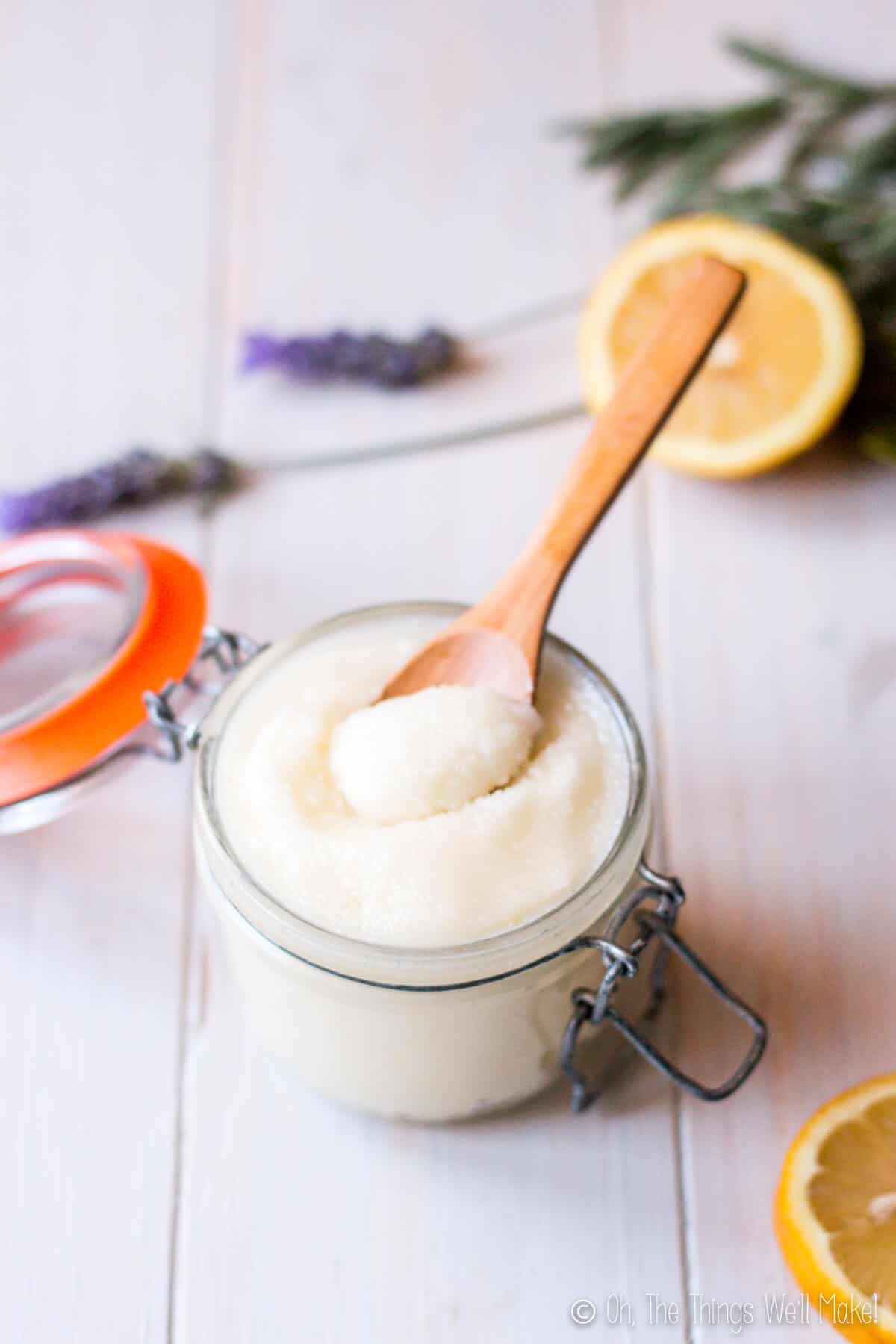
One of the most common DIY beauty products that can be found online is sugar and salt scrubs. Perhaps the main reason that these products are so popular is that they are very easy to make. Basically, you take some oil and mix it together with either sugar and salt, and you’re essentially done. Sure, you can customize your recipe with different oils, sugar types, essential oils, and/or add in other exfoliants or colorants, but most of these recipes are essentially the same.
I’m not going to criticize these recipes. In fact, one of the first DIY recipes on my blog was a brown sugar lip scrub. As you may have guessed, I mostly used it to exfoliate my lips, but also tried using it in the shower to exfoliate my skin.
The benefit of emulsified sugar scrubs
The problem with regular sugar scrubs is that they tend to be messy to use. The oil doesn’t provide a lot of structure for your product, so it’s usually hard to scoop into your hands to use in the shower. Sure, you can use coconut oil to give it more body, but as soon as the weather warms up, you’re back to a more liquid product.
You could, of course, add some butters and/or waxes to the scrub to thicken it, but we’re still left with the main problem with sugar scrubs, the oily residue. Because it’s an oil-based product, you usually end up with oil all over your hands, and body, and shower, as well as the container you’re using for your sugar scrub. I liked the smooth feeling of my legs and arms after exfoliating with my homemade sugar scrub but didn’t like the feel of the oily residue all over my body.
Emulsified sugar scrubs don’t leave that sort of oily residue behind. Because they include an emulsifier as one of their ingredients, when the oils and waxes of the product come in contact with water, they basically form an emulsion, or a lotion, on your skin while you are exfoliating away. In the end, emulsified sugar scrubs are like exfoliants and lotions in one product. You’re essentially making an exfoliating creamy cleanser right on your skin as you scrub away.
If you’re lazy like I am, and don’t like having to exfoliate, rinse, and then use lotion once out of the shower, this emulsified sugar scrub is the perfect solution. It leaves your skin clean, smooth, and lotioned up. (Is that a word?)
Watch me make this easy, emulsified sugar scrub:
Should you add a preservative to your sugar scrub?
Because this is still an oil-based product, without any water in it, you technically don’t have to add a preservative to it. The problem with not using a preservative, though, is that you use this product in a very wet environment and likely scoop it out of the jar with wet hands. The likelihood of moisture contaminating your product is very, very high.
That’s why preservatives are usually added to these types of products, and why you have to be very, very careful using it if you choose not to add a preservative. You could even consider adding less sugar and less wax to the scrub so that you end up with a thinner product that you could more easily dispense from a silicone travel tube dispenser or another type of flip cap dispenser. That would allow you to dispense the product without touching it and would help keep water from contaminating your product.
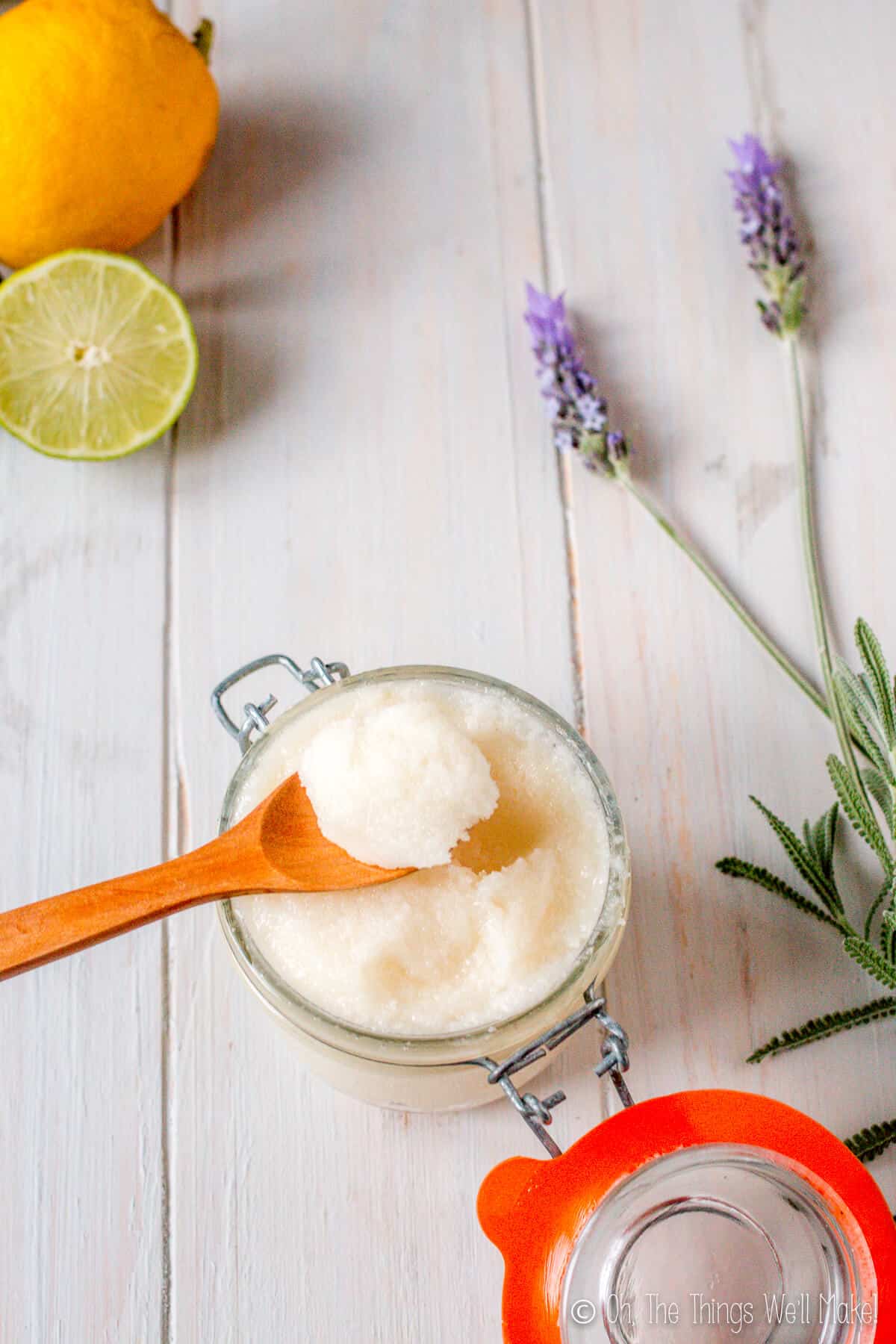
Customizing the emulsified sugar scrub
There are several ways that you can customize this recipe to better suit your taste.
Changing the exfoliant: Salt, sugar, or brown sugar?
While I made this a sugar scrub, you could just as easily add salt to the recipe instead. Salt tends to be a bit more abrasive because the granules aren’t as round and it takes longer for the salt to dissolve, but it really depends on the coarseness of whatever you choose to use. Brown sugar usually has smaller granules and tends to be a lot less abrasive, making it a great option for exfoliating your face.
How much sugar should I use?
When I first made the recipe, I used 120g of sugar and found it to be a nice texture. The next time I made it, I decided I would add more sugar, around 30g more, thinking I’d end up with a thicker scrub (and more of it). In the end, I think it may be a bit on the thick side (as you can see at the end of my video when I’m applying the scrub). It still works well, especially if you are applying it to wet skin, but is a bit harder to apply if it isn’t thinned out with a bit of water. I think somewhere between 120g-150g is a good guideline, and you can adjust the amount to achieve the consistency you prefer.
Customizing the fragrance
I used a combination of lavender, rosemary, and lemon essential oils because I tend to favor citrus herbal scents. You can change the essential oils, though, to suit your tastes. I like lavender because it is calming and soothing for relaxing after a busy day. Lemon can be both soothing or invigorating depending on what you mix it with and when you use it. I don’t normally measure out my essential oils, but use my nose to help decide how much to add.
Which emulsifying wax should you use?
You can use any emulsifying wax that you may happen to have on hand. If you make your own homemade lotions, you should already have one or two of them at home.
If you are very concerned about making a very natural emulsified sugar scrub, consider using an emulsifying wax like olivem. Olivem is a vegetable based emulsifier that is derived from olives. It is allowed in natural, organic products that use the ECO-CERT certification. Olivem is a great option for an emulsifying scrub, too, because some people say that it has a bit of a soap feel to it. In the case of a cleanser, that is more of an advantage than a disadvantage.
Basic, Easy Emulsified Sugar Scrub
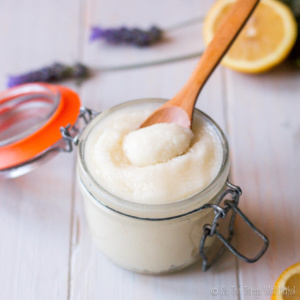
Emulsified Sugar Scrub
Ingredients
- 50 g oil I used sweet almond oil
- 10 g cocoa butter
- 10 g shea butter
- 10 g beeswax or candelilla wax
- 15 g emulsifying wax Olivem is a great choice for this!
- 1 g essential oil (I used lavender, rosemary, and lemon)
- 1 g cosgard or other natural preservative used at the recommended dose
- 150 g sugar (Use less for a slightly thinner product)
Instructions
- Weigh out ad mix together the first 5 ingredients: the oil (but not essential oils), butters, and waxes.
- Melt the oils, butters, and waxes over a double boiler (or in the microwave, if you prefer).
- Once melted, remove from the heat, and stir occasionally as the mixture cools. You can use a mixer to help blend everything together and make a creamy mixture, but it’s not essential.
- Once your mixture has cooled down quite a bit (ideally below 45ºC/115ºF), you can begin to add the essential oils and preservative.
- Make sure the essential oils and preservative are well incorporated into your oils and then begin to add the sugar. Add slowly, and stir constantly, so you can gauge the consistency of the product. Add as much sugar as you like to achieve the desired consistency. (I like it somewhere between 120-150g.)
- To use your sugar scrub, scoop out a small amount in your hands and begin to rub over your wet arms and legs (or any areas you want to exfoliate and hydrate) in a circular motion. As the mixture comes into contact with the water, a lotion will be formed, and the sugar will begin to dissolve, making the product smoother and less abrasive. Rinse any remaining sugar crystals off, and pat your skin dry. Your skin should now feel smooth and hydrated.
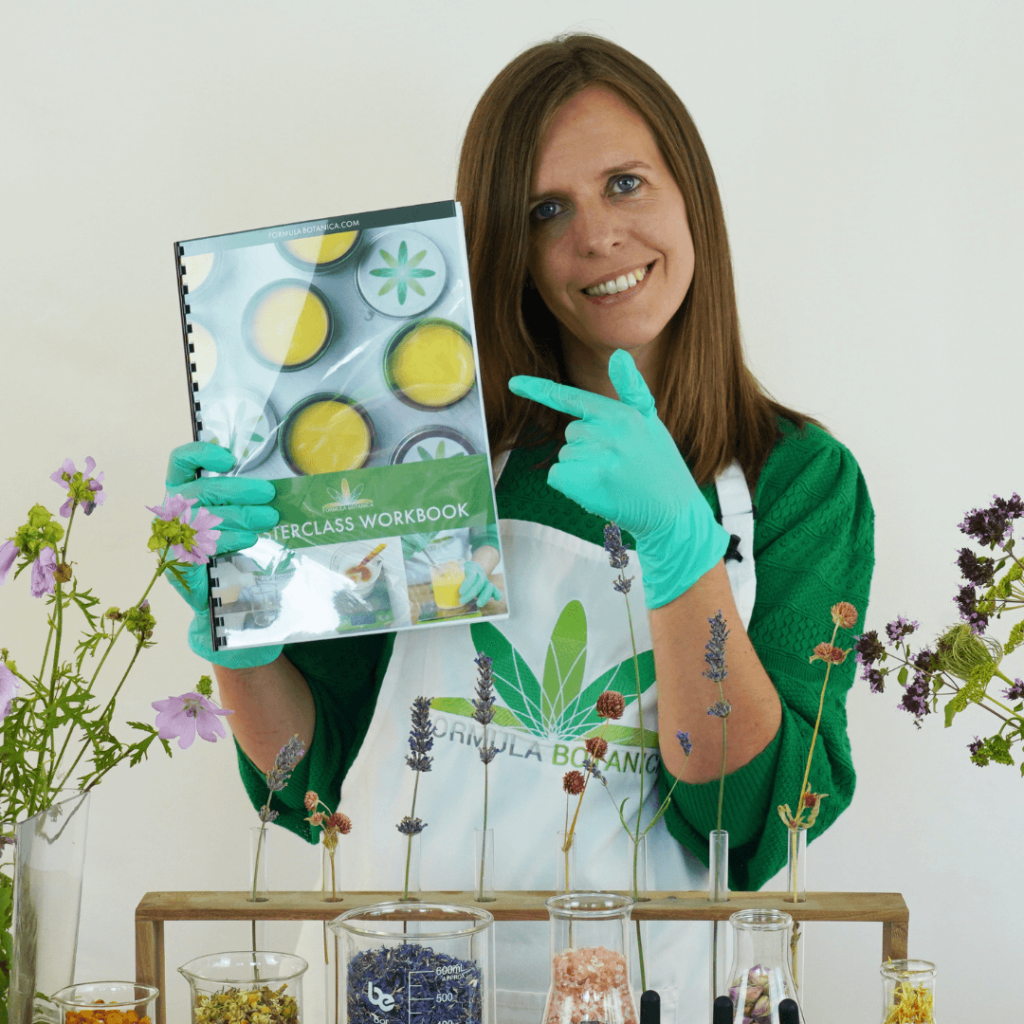
Free Formula Botanic Masterclass!
Running now…
9 free 10-minute classes to help you learn to begin developing professional-grade natural cosmetics in your own home!
 Español
Español
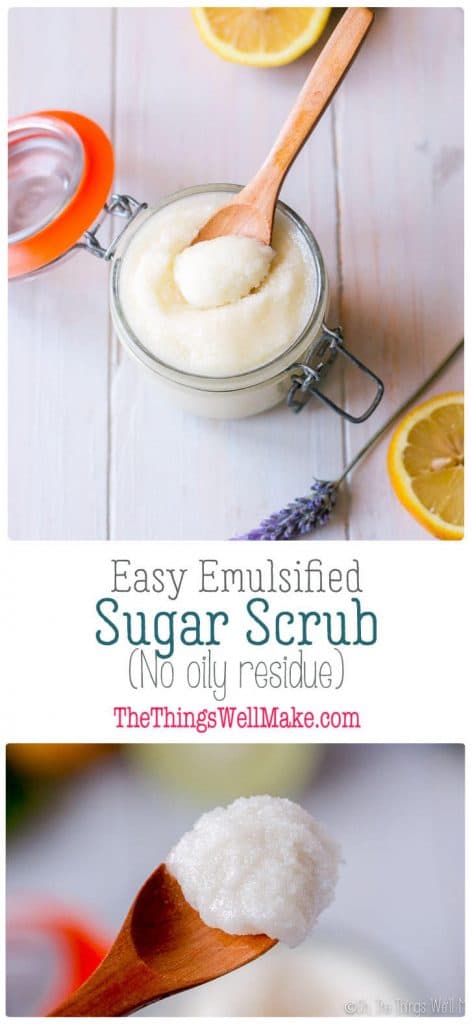
 What are Bitters, and How to Make Them
What are Bitters, and How to Make Them
Abagael
This turned out great and was so easy to make! Thank you 🙂
Tracy Ariza, DDS
Thanks Abagael! I’m so happy you liked it!
Hetty
hi, can I use creamMaker fluid instead of olivem?
Tracy Ariza, DDS
I have no experience using it, but I have tried a number of emulsifying waxes without issues.
If it works well for you making emulsions, you should be fine!
Fate
Tried this with olivem 1000 and beeswax it was really bad. I had to use soap to get it off.
Tracy Ariza, DDS
You can try making it without beeswax. The product won’t be as solid, but it does work for those who don’t like the feel of the wax on their skin.
Katja
I will try this recipe, but dont have Olivem as an emulsifying wax.
I have a wax from The Soapery, Cetearyl Alcohol and PEG 20 Stearate (SLS free). Can I use this?
Kindly Katja
Tracy Ariza, DDS
Katja,
That should be fine. I’ve since tried making this with numerous emulsifying waxes and they all were fine. You can also eliminate the beeswax for a lighter, softer product, if you like.